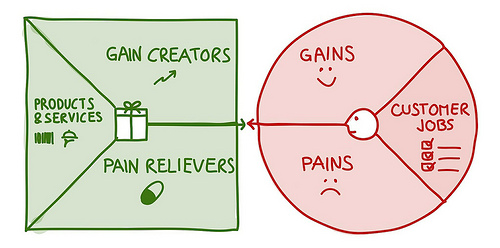A few years ago, I used to struggle to convince my clients to give me more — or just some — time to do a good customer research, and I must confess I lost a few battles. But eventually, I learnt how to manage it. I stopped fighting this. At first, I would listen to them carefully — after all, they are experts in their products. After that, I would let the force of a good methodology clarify whether their ideas would be the best way to make money. Once clients understand they may not make the profit they dreamed of, they usually allow more time for customer research. In this article, I will walk you through how I use the Value Proposition Canvas in my own work. I hope you find it useful.
The Puzzle
Most of the time, when someone comes talk to me to start a new project they usually know what they want. This means they already have a finished product in mind and just need someone to make it tangible. The ideas are always amazing, the imaginary product looks great when they are speaking. However, if I start asking questions related to potential customers, the answer is usually based on their own experience with almost no contact with people outside of their circle.
Just like many other designers, my work process starts with a phase of investigation and understanding of the challenge. I collect all kind of information about the company, competitors, benchmarks, analogues, and the potential or actual customers. In order to understand the customer’s point of view I frequently schedule some interviews. When I present the project timeline, some clients inquire ‘How can we make it shorter?’, ‘Why do we need to speak with customers? I’ve been in this market forever. I know them. I can point every pain and everything they want for you!’.
I faced this situation more often than expected within different environments. From small companies to big ones, all clients ask for the job to be done as inexpensively and quickly as possible. Even when you do a sprint they are always trying to negotiate — I know you know what I am talking about! In this article I won’t go through every step of those negotiations. I’m focusing on one step: the customer research.
I always thought it was my role to teach my clients the value of listening to their customers. In order to achieve that, I used to prepare a small presentation in the beginning of the project to explain all phases that the project should go through. Some clients relate to this format, but others don’t. Some want to skip this phase and start doing a more hands-on activity.
The turning point with these clients happened when I started applying the Value Proposition Canvas (VPC) as one of the first activities. By doing this I had an outstanding impact on the projects and on my current way of work. Now I understand that a good methodology is not only the one that you can use to create great things, but also the one the shows if the project is going the wrong way. That’s why I’m a fan of this canvas.
The Tools
I will explain this methodology briefly, for those who might not be familiar with it. In 2010, Alexander Osterwalder and his team launched the book Business Model Generation with the revolutionary canvas — Business Model Canvas (BMC). It was the end of the business plan era. This canvas made it easier to build and iterate a plan for a new business model. It has only nine building blocks, but in 2014, Osterwalder decided to write a new book to emphasize the two essential initial blocks, so he created the Value Proposition Canvas (VPC). I recommend you read his article to have a deeper view.
Basically the VPC can be used as the foundation of a project.
The canvas has two parts, the “Value Map” and the “Customer Profile”. They are connected by an arrow, trying to find a fit between them.
A simplified illustration of the canvas
The ‘Customer Profile’, is the circle. To fill it up you need to understand your customer’s point of view about the job to be done, their pains and gains. In this canvas, the ‘Value Map’, is the square. It’s how your product or service will deliver the benefits trying to answer their customer’s needs and pain-points. The connection between them is the fit. It verifies whether your product has potential to be accepted by this customer.
The most recommended way to use this canvas, is to fill up the ‘Customer Profile’ portion of it first, and then, based on this information, the team can figure out how the new product can answer the user’s needs, pains and gains. You are not required to use the canvas this way; in the official book they say you can start from wherever you want. However, most of the examples inside the book and in other articles used this classic way to fill up the canvas.
Extra!
Completing the canvas is a good start. When you find the perfect fit, you might also want to try the complementary Business Model Canvas and the Environment Map.
Bringing the Pieces Together
It’s common sense that the most effective learning methods are the ones where the people are active — this helps them experience the learning point. The best part is when a client asks me to do more research, it’s when I know they realized the real importance of this stage of the job.
Designers are often being empathic to customers, but sometimes we forget to do the same with our clients. We have the methodology and they have the knowledge of their field. That is why we should create together. Not for them but with them. Understanding the client’s way to see a project is the first step. Allowing them to express themselves in a more suitable way increases the probabilities of better connection between you and your client. It helps to start the relationship off on the right foot.
To make this clear, I’ll walk you through my working process:
I use the VPC during the first meetings. I bring at least three printed poster-size copies, a marking tape and some post-its. I briefly explain each of the blocks on the canvas without saying if there is any order to follow. I ask them to help me fill the blocks up to make sure that I understood all information related to the idea in the right way.
A canvas — any canvas! — is a collaborative document, and because of that, this is one of those moments that clients feel they are working with me. I start posting the first canvas on the wall and we start talking, writing and posting information as the conversation flows. I just ask “Can you explain your idea/project/product?”. Usually, they talk more about the idea than the customers. If during this section I realize they have more than one profile of customer, I post another canvas and we separate each profile into different board. At the end of the meeting we may see more solutions than pains. This happens because clients are in love with the idea they have, instead of understanding the problem we need to solve.
When we finish the canvas, I ask whether they are 100% sure and if they have any questions or concerns. I always try to be positive and , focus on the best part of the project. In order to complement the canvas and to avoid any blind spots I suggest to do a small research with 3 to 5 potential customers. They usually accept this. However, if I propose to do the same thing to discover the customer’s point of view my clients usually say ‘no’. This happens because they feel I am being condescending by devaluing their understanding of this field. But when I say that I will do a small research to complement what they know without leaving out their experience, they feel confident, because I’m really including them and their knowledge in the project.
Back to the canvas, I cluster all the information from the Customer Profile portion to write a script for the interviews. A good interview in that case is not a collection of direct questions, but a guide with open questions related to that bigger picture where the project belongs. To learn how to do an interview, I strongly recommend the book Talking to Humans — the Kindle version is only $0.99! Even if you know how to conduct an interview, check it out — it is a very good book!
After a few interviews with customers I get the same group in the room again to share what I have learnt. Using the same canvas, I take off a few post-its we posted in the first section, and post my new ones on the Customer Profile portion. I use a lot quotes do justify my post-its. I try not to speak as a designer, but at that moment I represent each potential customer. By the time I finish my presentation, my clients are on a good vibe. There is no longer a conflict between their opinion and mine. Instead, we realize this has been a great journey together, during which we have learned what’s best for all.
At this stage of the process, we realize how much we have learned from a small-scale research. It’s not unusual for clients to say something like “If our customer has different jobs to be done, pains, and dreams, than we should re-think our product accordingly”. This is when I jump up and down! This is also when we review the customer-research time frame, and decide to allot more time and effort to it.
***
To sum up, the Value Proposition Canvas has been very helpful for me in this scenario. Convincing clients, stakeholders and bosses of the importance of a deep research with real potential customers is a challenge in many projects. This is one way to do it. What is yours?
This article is adapted from a lecture I gave on June 10th, 2017, at the LA UX Meetup. The slides from this presentation are on SlideShare.
This content was created as part of the mission of Mola Collective, a Brazilian Collaborative Learning Platform with a mission to learn new ways to improve the world through the lens of design and share these learnings to help others improve their skills, leveraging business for people.

Matina wrote this story to share knowledge and help nurture the design community. All articles published on uxdesign.cc follow that same philosophy.


